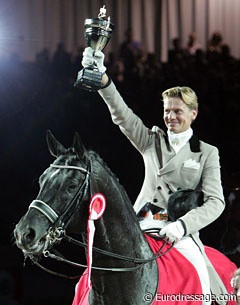
The silver anniversary of the World Cup Finals was painted black. Edward Gal and Tosca Visser's black KWPN licensed stallion Totilas prevailed in the Kur to Music finals in the Brabanthallen in 's Hertogenbosch, the Netherlands, on Saturday afternoon 27 March 2010. The ruling couple fulfilled all expectations and scored 89.800% to earn the World Cup trophy.
Though the point difference with second placed Adelinde Cornelissen was considerable (82.850), winning title was not Gal and Totilas' usual walk in the park. The sympathetic 40-year old Dutch rider definitely felt the pressure after oddly 'losing' to Adelinde in the Grand Prix.
"When I went in the ring, I was really terrified," Gal admitted to the crowds during the prize giving ceremony. He was unsure whether Totilas would be a hot tamale as he was in the Grand Prix or not. But as the test progressed and level of greatness were being reached, Gal felt more relaxed and was able to enjoy the ride.
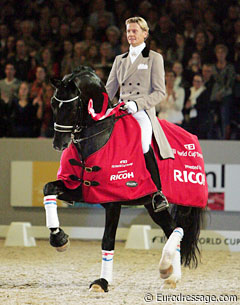 Gal's kur was a major improvement to the Grand Prix. The horse was more comfortable in his work and a bit more open in the frame. The dramatic tunes of his score are overwhelming, even though one never gets the impression that Gal is riding "to" music, the hammy sounds are more the background tunes of an impressive technical test "with" music.
Gal's kur was a major improvement to the Grand Prix. The horse was more comfortable in his work and a bit more open in the frame. The dramatic tunes of his score are overwhelming, even though one never gets the impression that Gal is riding "to" music, the hammy sounds are more the background tunes of an impressive technical test "with" music.
The half passes in passage had great bounce, the extended walk was very good as well as the extended canter. In the collected walk, Totilas tilted his head to the left and the trot extensions showed hardly any true lengthening of the frame in spite of the one hoof overtrack. The hindquarters swung to the right in the two tempi's but they were uphill. The ones were outstanding.
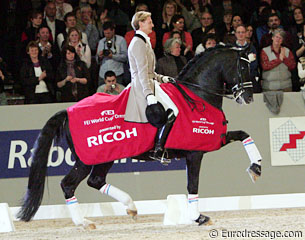 Totilas is an expert in pirouettes and impeccable transitions to and from piaffe. Here and there a few irregular steps were noted in the passage (with distinctively more left hind leg usage) but the crowds were impressed nonetheless, as were the judges. As last rider to go Gal received a standing ovation from the roaring audience who rejoiced with him when the 89.800% score flashed on the board.
Totilas is an expert in pirouettes and impeccable transitions to and from piaffe. Here and there a few irregular steps were noted in the passage (with distinctively more left hind leg usage) but the crowds were impressed nonetheless, as were the judges. As last rider to go Gal received a standing ovation from the roaring audience who rejoiced with him when the 89.800% score flashed on the board.
"It was fantastic," Edward commented during the press conference. "I was a little tense myself as I didnt't know how he would react today. In the middle of the test I felt I could breathe again and ride. He felt really good."
The Harskamp based rider confirmed that his horse is gaining in strength and fitness but that it also involves more skilled riding. "It's getting easier for him. When he has lots of power in the ring, he can also use it against me and then I'm in trouble."
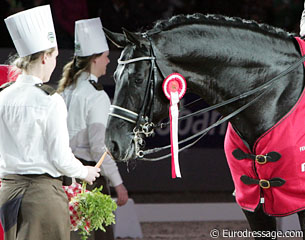 Edward's goal this year are the World Equestrian Games. "First I will rest and he will rest," he said. The road to Kentucky for the Dutch goes via the CDIO Rotterdam and Hickstead as official selection trials (atypically excluding the Dutch Championships in De Steeg). Gal and Totilas will ride both, and probably throw in one extra show in May to stay on form.
Edward's goal this year are the World Equestrian Games. "First I will rest and he will rest," he said. The road to Kentucky for the Dutch goes via the CDIO Rotterdam and Hickstead as official selection trials (atypically excluding the Dutch Championships in De Steeg). Gal and Totilas will ride both, and probably throw in one extra show in May to stay on form.
His second place in the World Cup Grand Prix has created windows for the competition to beat the so-called "unbeatable" horse. Gal remains very realistic in his outlook on the future. "I never had the feeling that we were untouchable," he admitted to Eurodressage. "I want to have competition, otherwise we'll be standing still. I need to stay focused."
Adelinde Cornelissen and Parzival cracking nuts
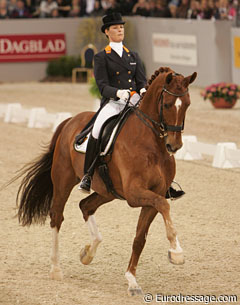 The one rider currently in the best position to beat Totilas is team mate Adelinde Cornelissen. In the Kur to Music the cheerful young lady finished second with 82.850%, a score almost a full 7% lower than Gal. Adelinde rode to brand new music, exchanging Wagner's Parzival for Tchaikovsky's Nutcracker Suite, but kept her old choreography except for a minor change at the end.
The one rider currently in the best position to beat Totilas is team mate Adelinde Cornelissen. In the Kur to Music the cheerful young lady finished second with 82.850%, a score almost a full 7% lower than Gal. Adelinde rode to brand new music, exchanging Wagner's Parzival for Tchaikovsky's Nutcracker Suite, but kept her old choreography except for a minor change at the end.
The entry-halt-salute was self-assured and followed by an extended trot. In the first piaffe, Parzival lost his forward drive, but the passage had great elevation. The zig zag in trot was excellent. The extended walk had good overtrack but the horse needed to stretch his neck more. The one tempi's were completely straight even though Adelinde had an unscripted break in them on the centerline. The highlight of the test were the pirouettes ridden totally 'n sync to piano music.
Towards the end of the ride, Cornelissen was more hanging on the left rein and the quality of the piaffe went down a bit as the horse was pulling up his hocks instead of taking the weight on the hind quarters. The beautiful final movement was a piaffe pirouette at X fan-tailing from one direction to another supported by lovely bell tunes. In general Adelinde's new freestyle contained memorable new musical elements, but there was not a consistent story in it taking the viewer on a sentimental ride. Cornelissen scored 82.850% and became reserve world cup champion.
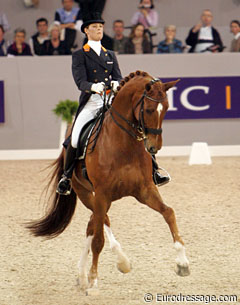 "Parzival was really good. I was pleased with that. He was very relaxed," she said. " I really blame myself for making that mistake in the one tempi's. But I'm absolutely satisfied with his way of going. There wasn't a second of tension."
"Parzival was really good. I was pleased with that. He was very relaxed," she said. " I really blame myself for making that mistake in the one tempi's. But I'm absolutely satisfied with his way of going. There wasn't a second of tension."
Cornelissen had only practiced her new freestyle once. When asked why she changed her music so quickly (her Parzival freestyle was one year old), she replied, "If I hadn't changed the kur, I would certainly not have won." Unlike some other riders who compete to the same music for at least six years in a row and bore the audience with their predictable repetition, Adelinde wants to stay new, fresh and exciting in her kur choice. Working on her new freestyle was not really been a strenuous process. "I hardly dare to say it but we only started to work on it in February," she said.
Imke Schellekens-Bartels and Sunrise, Performance of a Lifetime
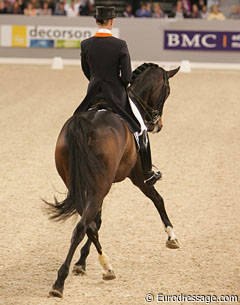 Those who thought that Imke Schellekens-Bartels and Sunrise were at their best ever in the Grand Prix on Thursday were mistaken. Their World Cup Finals' kur to music was a performance of a lifetime and it would not have surprised anyone if they had overtaken Cornelissen and finished second with an even higher score than 82.150%.
Those who thought that Imke Schellekens-Bartels and Sunrise were at their best ever in the Grand Prix on Thursday were mistaken. Their World Cup Finals' kur to music was a performance of a lifetime and it would not have surprised anyone if they had overtaken Cornelissen and finished second with an even higher score than 82.150%.
Riding to her delightful piano inspired Wibi Soerjadi freestyle, Schellekens and the Smarius family owned Sunrise (by Singular Joter x Werther) did not have an immobile halt and in the first extended trot there wasn't enough overstep.
But it all went up from there as each musical segment built up to a new movement. The piaffe was rhythmical (maybe the first one a tiny bit too forward), the extended walk relaxed. Imke performed 19 one tempi's, all clean and straight.
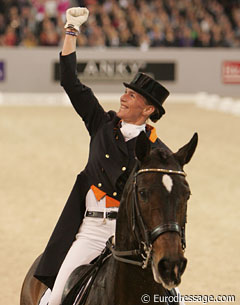 The double pirouette to the right could have had a bit more bending, but the contact with the bit was overall always very steady. All piaffe and passage were extremely well regulated despite the flicking tail and Schellekens absolutely excelled in the total control over her horse and her fault free presentation.
The double pirouette to the right could have had a bit more bending, but the contact with the bit was overall always very steady. All piaffe and passage were extremely well regulated despite the flicking tail and Schellekens absolutely excelled in the total control over her horse and her fault free presentation.
"I'm very proud of my horse," Schellekens commented. "At home I felt this was going to be my best event of the season. She was so controlled, loose. This is what dressage is about."
Imke has felt the improvement in her horse the last few months. "My horse is more settled and I'm more experienced. I am more sure when not to panic in the test. The border between relaxation and utter power is getting better. I hope that I will keep improving so that I can keep up with the other Dutch."
Werth, Best of the Rest
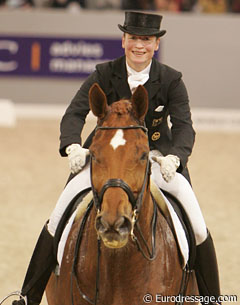 The fourth place went to the 2007 World Cup winners, Isabell Werth and Warum Nicht. The German rode to her oooooooooooold music of her former Grand Prix horse Apache OLD and so far hasn't shown any intention to renew her freestyle with something that could put her back in the running with her Dutch rivals. Werth's "Land of Hope and Glory" kur is gorgeous though, but even great old things get out of fashion after a while.
The fourth place went to the 2007 World Cup winners, Isabell Werth and Warum Nicht. The German rode to her oooooooooooold music of her former Grand Prix horse Apache OLD and so far hasn't shown any intention to renew her freestyle with something that could put her back in the running with her Dutch rivals. Werth's "Land of Hope and Glory" kur is gorgeous though, but even great old things get out of fashion after a while.
The 14-year old Hanoverian Warum Nicht FRH (by Weltmeyer x Wenzel) was on a mission with his rider and did an excellent job. Some loss of rhythm in the first passage half pass was made up with brilliant trot extensions. Though one piaffe lacked impulsion, the rest was always very rhythmical and even. The zig zag was well regulated as were the one tempi's synchronized to great canter music. The two tempi's had to cover more ground.
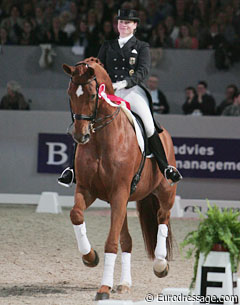 At all times, the connection with the bit was exemplary. Werth is a master at keeping a nice soft contact without annoying the horse in his mouth. The pair scored 79.750%, a far cry from the winning 84.250% they got at the 2007 World Cup Finals.
At all times, the connection with the bit was exemplary. Werth is a master at keeping a nice soft contact without annoying the horse in his mouth. The pair scored 79.750%, a far cry from the winning 84.250% they got at the 2007 World Cup Finals.
"I was very satisfied with Hannes. He felt really good the whole test," said Werth. "I could take risks. I think I didn't get too many points. Both my horses were much better today. So we have to fight to come closer again." Werth also joked, "there are too many Dutch here."
Werth will make her next show appearance at a local event in Hünxe, Germany, where she will compete her youngsters. Her first big outdoor show with her top horses is Mannheim.
Kittel and Scandic Enthuse the Crowds
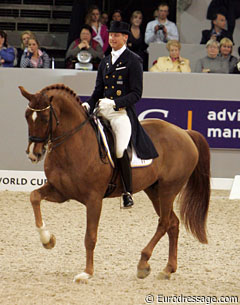 An absolute crowd favourite were Swedish Patrik Kittel and the Dutch registered stallion Scandic. The energy sparkled throughout Kittel's Depeche Mode freestyle and Scandic was on a roll. The chestnut stallion has world class trot extensions with super suspension. In piaffe and passage he maintains a stead rhythm with incredible bounce, unrivalled by any of the higher scoring Dutch ridden horses in elasticity in combination with such high level of relaxation! In the half pass right he tilted his head and the extended walk was not clear in rhythm despite the 2 hooves overtrack. The tempi changes were uphill but there was a loss of collection in one of the pirouettes.
An absolute crowd favourite were Swedish Patrik Kittel and the Dutch registered stallion Scandic. The energy sparkled throughout Kittel's Depeche Mode freestyle and Scandic was on a roll. The chestnut stallion has world class trot extensions with super suspension. In piaffe and passage he maintains a stead rhythm with incredible bounce, unrivalled by any of the higher scoring Dutch ridden horses in elasticity in combination with such high level of relaxation! In the half pass right he tilted his head and the extended walk was not clear in rhythm despite the 2 hooves overtrack. The tempi changes were uphill but there was a loss of collection in one of the pirouettes.
Kittel posted a score of 76.550% to finish fifth. The audience reciprocated with loud booing and most connoisseurs agreed that an 80% mark would have been more justified for such a ride.
"This is such an amazing show. I'm proud to be here because I dreamt of doing this when I was younger," Kittel commented.
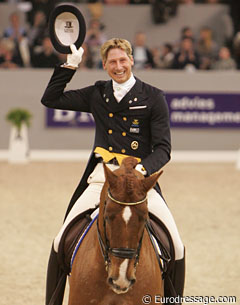 Eurodressage went up close and personal with Patrik Kittel to ask about his partnership with Scandic and his future plans. "I just have to ride better and compete. The scores will get better. I ride to be a better rider. But the most important thing is to be happy and to have happy horses," he told Eurodressage.
Eurodressage went up close and personal with Patrik Kittel to ask about his partnership with Scandic and his future plans. "I just have to ride better and compete. The scores will get better. I ride to be a better rider. But the most important thing is to be happy and to have happy horses," he told Eurodressage.
Scandic's major issues was his inability to stay uphill in canter but this was not the case at the World Cup Finals. "He gets more up by stretching him down in all positions. You have to variate the form." When asked about Scandic's sensitivity in the mouth, Kittel responded that "he feels very sensitive in my hands. The more through he comes, the more soft he will be. I never ride him with a whip because he gets responsive with small transitions. He never stops going and that's what I love about him."
Judging the Kur
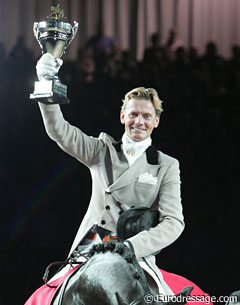 The assessment of the artistic part of the kur to music was the judges' achilles heel as the panel consisting of Schule, Tornblad, Verbeek, Rockwell and Truppa seemed in unison on a technical level (a praise-worthy achievement on its own), but quite scattered with their artistic appreciation.
The assessment of the artistic part of the kur to music was the judges' achilles heel as the panel consisting of Schule, Tornblad, Verbeek, Rockwell and Truppa seemed in unison on a technical level (a praise-worthy achievement on its own), but quite scattered with their artistic appreciation.
On the artistic level, Isabell Werth scored 81% with Tornblad and 93% with Verbeek. The same duo did not agree on Cornelissen's kur as the Dane scored it 83% and the Dutch judge 92%. Major discrepancies which are often ignored as the artistic score seems of minor importance to the appraisal of the test, yet decisive in the overall score. The general tendency is simple: a high technical score equals a high artistic one, no matter how synchronized the rider was to his music or how beautifully composed the kur was. Cut-and-paste cookie cutter or tailor made compositions, it hardly matters as long as the test is ridden well. Isn't it time for a clear system on how to judge the artistic part? Maybe the FEI can help the flustered judges by providing them with a helpful tool or at least clearer guidance on how to score it fairly, don't you agree?
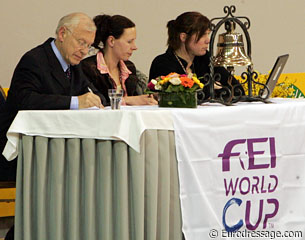 It also has to be noted that it doesn't pay off for the riders to have a difficult choreography. Complicated lines and movements are not amply rewarded in comparison to the super easy straight line - diagonal/centerline - planning of many top ranking dressage riders. They can do baby Grand Prix horse tests choreography-wise and still get higher marks than any rider who is innovative and technically more skilled in riding his or her horse.
It also has to be noted that it doesn't pay off for the riders to have a difficult choreography. Complicated lines and movements are not amply rewarded in comparison to the super easy straight line - diagonal/centerline - planning of many top ranking dressage riders. They can do baby Grand Prix horse tests choreography-wise and still get higher marks than any rider who is innovative and technically more skilled in riding his or her horse.
Text and photos © A.Appels/Eurodressage.com